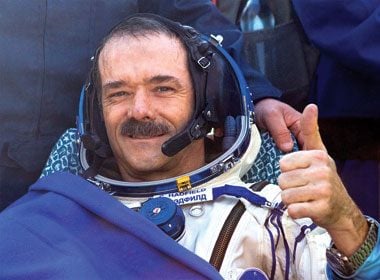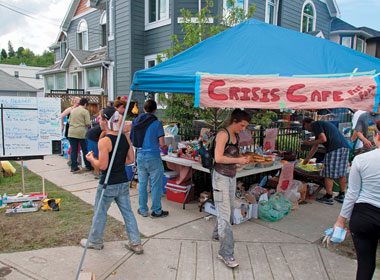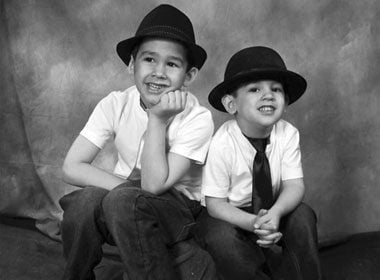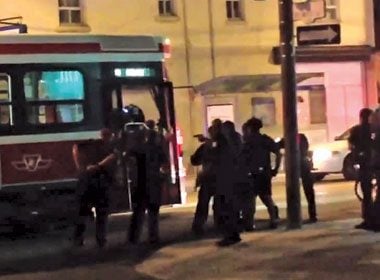
Chris Hadfield Returns to Earth
After five months on the International Space Station-delighting Twitter followers and the world at large with his musings-Chris Hadfield returned to Earth in a three-man capsule. On May 13, he landed in the steppes of Kazakhstan.
“You plummet into the atmosphere in a crash seat custom-poured for your body. You’re in a pressure suit. You have a four-point harness across your shoulders and waist, all laced through a big buckle in the middle. There are also cross straps across your knees. You’re utterly belted in. You’ve been warned to stop talking before impact so you don’t bite off your tongue. That’s how violent it is. A huge parachute opens above you, which slows you down a lot. Just before you land, retrorockets fire, which slow you down some more. But the Soyuz spacecraft you’re in still hits the ground like a dumpster of bricks. Except now you’re tumbling over sideways, plowing your way through the earth. You come to a stop, and where there was space outside your window, there’s now dirt. You can smell it. It’s something you haven’t smelled in half a year.”

Calgary Flood
By June 21, torrential rainfall had left large areas of Calgary flooded, resulting in one of the worst natural disasters in Alberta’s history. Information Technology salesman Stuart Quinn’s home was unaffected. But the next day, his lifelong friend Larry Kwan called to say his Sunnyside neighbourhood was underwater. Quinn went to help.
“We set up this thing called the Crisis Café, which started as a way to feed people. The phenomenal thing is how food just showed up. Someone would come with a wagon full of homemade sandwiches. Coffee companies would bring huge vats of coffee. A mother and her little girl even set up a lemonade stand across the street. At suppertime, pizzas would turn up, or lasagna. This happened every day-full meals to feed 300 or 400 people. At the café we devoted part of a board to list “supplies needed”-stuff like gloves, garbage bags. People would snap pictures of the board, which they’d send on social media, and the supplies would suddenly materialize. We were also a volunteer centre. Neighbours needing help would drop by, and we’d put their addresses on the board. When volunteers came, we’d send them out to the different addresses. A great deal of the labour involved pumping out homes and ripping out basements. It was grimy. And the volunteers returned, day after day. Some homeowners worked right next to them; some of them were so overwhelmed they sat on their steps and wept-but all were very appreciative. Faith in humanity and the people of Calgary was at an all-time high.”

The Death of Cory Monteith
On July 13, 31-year-old Glee star Cory Monteith was found dead on the floor of a Vancouver hotel room from a lethal mix of heroin and alcohol. Friend and acting coach Andrew McIlroy talks about the moment he heard the news.
“We were supposed to have breakfast that day, but I didn’t hear from him. He had a busy schedule so it wasn’t unusual for us to miss each other. Later that evening somebody Cory knew got in touch. When he told me, I fell down in shock. It was horrible. I couldn’t sleep. Honestly, I can’t remember a lot about that night. Did his death surprise me? Yes and no. I had seen him about a month earlier, after he had come out of rehab again. He flew up to see his mom. He seemed happy to be off the hell train. But as someone who has spent 25 years in recovery, I can tell you that this is how it happens-all of a sudden, the bad thing seems like a good idea. Sobriety requires 100 per cent of your focus. We have to acknowledge that addiction isn’t a moral failing. It’s about being ill, not about being weak. This is a horrible thing to say, but Cory was so sweet and loving and talented that he may turn out to be a good cautionary tale about the dangers of addiction. In Glee, he made the fat person feel good and made the gay person feel special and made the not-popular person feel all right. That’s why his role became so important. There are cafeterias full of teenagers hoping that the really handsome high school quarterback will make them feel like part of the team. So if one of his young fans thinks twice about having that drink or that stupid pill to be cool, if his death has put doubts into the mind of any of his admirers, then it meant something.”

The Birth of the Royal Baby
With the royal baby’s due date growing closer, CTV reporter Ben O’Hara-Byrne set up camp outside the Duchess of Cambridge’s hospital wing in London. Young Prince George finally entered the world on July 22.
“Near the start of July, media from around the world began staking out the best real estate-a colleague arrived that first week and marked our spot with gaffer tape. The gathered journalists became a bit of an attraction. Tourists would drop by and take pictures. ‘Still waiting’ were the words reporters were saying in every language. ‘Still waiting,’ ‘Still waiting,’ ‘Still waiting.’ As the wait continued, excitement waned. But when Kate went into labour, the thrill shot right back up. You realized why you’d been standing there, for the better part of three weeks, staring at a door. Thirty-six hours later, when the couple walked out, a hush came over the crowd and then a wave of phones and iPads surged in the air. The craziest thing was how fans were elbowing one another the way the media does in these situations. The audience was pushing to get a good photo. Still, it was a pretty exciting 20 minutes.”

Google Glass
Google Glass was the most anticipated innovation of the year. As part of the rollout, Toronto tech writer Tom Emrich test drove a pair on June 28.
“It arrived in the late afternoon, and I didn’t take it off until I went to bed around midnight. I was pretty giddy. You slip it on like glasses, and a tiny screen floats above your right eye-it’s like watching a large HDTV from three metres away. You’re basically walking around with the equivalent of a $1,500 laptop on your head. One day, I wore it into a coffee shop and someone screamed, ‘It’s the inventor of Google Glass!’ A few people lined up to try it. Only 10 of us in the entire country were sent the device, so there’s a sense of being first, of being the ultimate early adopter, of owning a piece of the future.”

Yukon Bar Patron vs. the “Sourtoe Cocktail”
For 40 years, the “sourtoe cocktail”-a mummified human toe served in a shot glass of hooch-has drawn adventurous drinkers from all over the world to Dawson City’s Downtown Hotel in Yukon. On August 24, “Toe captain” Terry Lee served an unexpectedly zealous patron.
“Near the end of the evening, a guy comes in and says, ‘I’d like to do the toe.’ So I give him the spiel: if the toe is bitten, chewed or swallowed, it’s a $500 fine. All you’re supposed to do is tilt the glass back, down the drink and let the toe touch your lips. But he immediately takes the toe into his mouth. Then he slugs back a beer and says, ‘I swallowed it.’ He slams $500 on the table in $100 bills. I was in shock. I never expected that in a million years. And as toe captain, I’ve handled as many as 124 servings of Sourtoe an evening. We usually have two toes on hand and switch them off once a week. Until that point, $500 had been a pretty good deterrent. We’ve since upped it to $2,500.”

Arctic Kingdom Adrift at Sea
In early summertime, tour operator Arctic Kingdom was travelling with 12 tourists on a polar expedition in Arctic Bay, Nunavut, where they set up camp on the ice. On the morning of June 25, guide Jason Hillier discovered the group was adrift at sea.
“We woke to the blaring of GPS anchor alarms. Looking around, we realized our view of the sea cliffs had shifted. ‘Oh crap,’ we said, ‘we’ve broken free.’ We were now floating out on an ice island nine square kilometres big and up to two metres thick. I’ve been doing tours for 14 years and have never witnessed anything like it. We activated our distress signal. It was snowy and very windy, with water as far as the eye could see. We drifted for about 16 hours, always looking for a chance to get off. Then, around 11 o’clock that night, we bumped up hard against shore. Solid ground was a relief.”

The Death of Rita MacNeil
On April 16, Rita MacNeil died in a Cape Breton hospital following complications from surgery. Kim Dunn, her keyboard player for over 13 years, found out early the next morning.
“I got the call from Bruce Dixon, our bass player. It was about 2:30 a.m. Bruce didn’t say much-something to the effect of ‘She’s gone.’ I stayed up and played some of Rita’s music. When she had a good song it could move you in a very special way. I thought about the last time I had seen her: the weekend of the East Coast Music Awards, a month earlier. Rita went by with her friend Rose. They were headed for the exit, and I had the sudden impulse to speak to her. I chased after Rita, and when I caught up, she was getting into her car. We hugged and laughed and said goodbye, and that was it. That was the last time.”

Lac-Mégantic
Anne-Josée Orichefsky and her three young children were sleeping at her parents’ home in Lac-Mégantic, Que., on July 6, when a train filled with crude oil derailed and exploded. The accident destroyed homes and businesses, killing 47 people.
“The phone rang at about 1:25 a.m. It was my sister. She and her partner live at the other end of Lac-Mégantic and had been woken by what sounded like a huge clap of thunder. Her partner’s a volunteer firefighter and was told that a train had exploded downtown. None of us could go back to sleep, so we walked to a nearby hill where a crowd had gathered. We watched mushrooms of fire rise into the sky. I lost a childhood friend, a neighbour I saw grow up. The night after the blast, my seven-year-old daughter was crying, too scared to go to sleep. She was scared she was going to die, engulfed in flames. And now, when my four-year-old son plays outside, he washes his trucks because they’re ‘full of gas.’ His trains always end up exploding.”

Connor and Noah Barthe
On August 5, during a sleepover in Campbellton, N.B., Connor and Noah Barthe- age six and four-were strangled to death by a 45-kilogram python that had slithered into their room after escaping from the pet store below. Bry Loyst, a Canadian reptile expert from Peterborough, Ont., was called to the scene.
“After the boys’ deaths, the Ministry of Natural Resources asked my team to remove any animals in the collection that were illegal. Walking into the building, I remember the smell. Just nasty. There was a basement, where the owners kept four large alligators in an enclosure; a middle floor, where the pet shop was located; and then stairs that connected the shop to the living quarters above-that’s where the two boys had been. We ended up going through every room, because there were animals on each floor. We carted away 27 reptiles, including turtles and snakes. Crayon marks were all over the walls. The whole house was like a colouring book. Drawings and kids’ names, everywhere you turned. When I finally got to the room where they died, I stopped. I was alone in there for quite a while, thinking it through.”

Ottawa Bus and Via Rail Crash
Office manager Romi Gupta was riding the 76 to work On September 18 when the Ottawa bus crashed into a Via Rail passenger train. The collision claimed six lives.
“I was the last one to get on the bus. It was very full. Standing above me on the stairs was a cyclist; he was wearing a helmet and a beautiful yellow jacket. He said, ‘I want to watch my bike-why don’t you come up?’ So we swapped spots. Ten seconds later, the impact happened, and I saw him fly. The front of the bus was totally ripped open, and passengers had been thrown to the tracks. I saw the driver in pieces. There was another guy lying there, looking at me for help. I felt so helpless-so helpless. And that guy in yellow? He wasn’t moving. At the time, I didn’t know his name. I just knew he had saved my life.”

Journey of Nishiyuu
Inspired by the “Idle No More” protests, 18-year-old David Kawapit organized the Journey of Nishiyuu, a 1,600-kilometre walk that retraced the traditional trade routes of the Cree, Algonquin and Mohawk. On January 16, leading a group from Whapmagoostui, Que., he arrived at the Parliament Buildings. The trip took 68 days.
“We’d get up around 7 and be out of the cabin or tent by 9. And we’d spend the day walking. The first couple of weeks, it was just seven of us, and then there were more than 100. The youngest walker was three; the oldest in his 60s. We all got along, pretty much. It was rare you’d see someone down. When I thought I couldn’t go on, I told myself that I’d already been through so much that if I quit, it would’ve all been for nothing. Reaching Ottawa left me with a lot of mixed emotions. I didn’t expect there to be thousands of people waiting. But I had finished something I didn’t want to end, you know? I felt it worked. I did the walk, I brought out leadership in people who didn’t know they had it. I’m hoping other people are inspired to take the next step.”

Quebec Soccer Federation Turban Ban Reversal
The Quebec Soccer Federation (QSF) reversed its ban on turbans-which it had claimed were a safety risk-on June 15, allowing vaudreuil resident Gagandeep Mukkar’s six-year-old son, Rasnamjeet, to play for his local team for the first time.
“Rasnamjeet was thrilled when he joined his friends on the field. All the parents were cheering. He ran to the coach and said, ‘I’m here to play.’ As a family, and as a Sikh community, we felt loved. There was a lot of solidarity against the ban. One coach had his entire team wear patkas. Some non-Sikh parents pulled out their kids in outrage. To this day, I’m boggled by the reason for the rule. Why was the patka a security threat? Still, I’m thankful the QSF came around. Like my husband and I told our son, always raise your voice against what’s wrong. And you know what? His team ended up winning that game-they called him the lucky charm.”

The Cronut Burger
On August 21, 150 people became ill after eating the “cronut burger”-a patty served in a croissant-doughnut pastry bun-at Toronto’s annual Canadian National Exhibition. Among the afflicted was new-media artist Mitchell Chan, who attended the fair with his wife.
“The Cronut burger was served on a cardboard plate and looked terrible! It included a beef patty, a slice of processed cheese and bacon jam that looked like they had squirted cat food out of an icing gun. When I took a bite, it tasted like a very stale cinnamon doughnut. Frankly, I didn’t want to finish it, but I’d forked over $11. Several hours later, we sat down for a beer. That’s when everything started spinning, and I ran to a garbage can and had a, um, reversal. It was clear I needed to leave. We got on the bus, but after a few stops I felt queasy again. I rushed to the exit and barely made it past the doors when I was sick. I made it home and slept it off. I was back at work the next day. I thought about starting a ribbon campaign for Cronut victim survivors, but we’re not a sympathetic group. There’s a feeling we had it coming because we exercised our right to eat a 5,000-calorie abomination of religion and science.”

Beyonce’s Hair Malfunction
Pop diva Beyoncé experienced a major hair malfunction during her Montreal show on July 22. Librarian Nikki Tummon watched as the singer’s notorious tresses got stuck in a whirring fan.
“Beyoncé was singing ‘Halo.’ She likes to get up-close-and-personal, so she walks to the edge of the stage and goes to sit down and sing to her people. Suddenly there’s a bodyguard getting in front of her. No one ever gets in front of Beyoncé. When there’s some big windbreaker guy standing in front of her, it means there’s a pretty serious problem.”

Love at First Sight on a Vancouver Bus
On August 6, Nina Schmidt and Jarred Greff tied the knot on a Vancouver bus as a nod to their love-at-first-sight meeting a year and a half earlier-on main Street’s No. 3.
Jarred Greff on their initial encounter:
“She sat three seats away. We both smiled at each other. Then the woman in the seat closest to her got up. The only words going through my head were, ‘Stand up! Just stand up!’ So I walked over and took the seat. As a hairdresser, it’s my job to talk to women all day. Normally I’m very good at it, but at that moment, my conversational skills could not have been worse. I just pretended to stare out the window. Nina leaned over and asked if I’d said something. I said no, laughed and introduced myself. She told me she was going to a friend’s, and I told her I was going to work. When she said, ‘Oh, this is my stop,’ I panicked-I still hadn’t sealed the deal. ‘You should stop by the salon,’ I fumbled. And she said, ‘I totally would, but I have a good friend who’s a hair-stylist and I could never cheat on him with someone else.’ I said, ‘I don’t want to cut your hair. I just want to say hi.’ And with that, she stepped off the bus.”
Nina Schmidt on what happened next:
“On my way to my friend’s place, I was smiling like crazy. I told her and her husband the story. He’s a redhead, like Jarred. And he was like, ‘You have to see him. Once you go ginger, you never go back!’ So I went looking for his hair salon, and I felt really great when I stepped through the door and he walked toward me, smiling. Jarred asked for my number and called me the next day, which is good, too-Vancouver men wait forever. Our first date lasted 22 hours. We got married 18 months later. When Jarred and I started talking about the wedding, we agreed, ‘We have to do this on a bus. It means a lot to us.’ It was a surprise ceremony. I entered through the back of the bus and walked up the aisle. Jarred’s father officiated, and I wore my mother’s wedding dress. At the end, the bus driver printed off a fare stub at the exact moment we signed the certificate. It was really sweet.”

The Boston Marathon Bombing
Montreal Personal trainer Monique Raymond had just finished her run in the Boston Marathon on April 15, when two pressure-cooker bombs exploded, leaving three dead and 264 injured.
“I was on my way to meet my friend when I heard the first blast. I ducked reflexively as the sound reverberated along the buildings. I asked a nearby cop about it. He said, ‘Probably just construction.’ He didn’t seem too worried. Then the second blast came, and soon after, his walkie-talkie squawked. He answered it and then took off. I still had no clue what was going on. About 20 minutes later, when I turned the corner, I saw runners hugging their loved ones and crying. I asked one woman what happened. She said there had been an explosion at the finish line. I didn’t think ‘terrorist attack,’ because this is Boston, it’s a marathon. I finally located my friend on the next corner. By now, all hell had broken loose. Ambulances and fire trucks were racing past, and cops were shouting at people to clear the area. It was surreal. We caught a ride to our hotel from a photographer who told us that it was a bomb and there were casualties. As soon as we got back, our phones started ringing, with everyone asking, ‘Are you okay, are you okay, are you okay?'”

Senatorial Shenanigans
Senator Mike Duffy has raised eyebrows over expense reports, breach of trust and where he actually lives. In early September, in Duffy’s riding of Cavendish, P.E.I., neighbour Debbie Eisenhaur bumped into him.
“I drove to the post office and saw another car in the parking lot. As I pulled in, I did a double take: it was Mike Duffy. He was dressed casually and looked relaxed. We exchanged hellos. He commented on his mail-something about the Canadian Cancer Society-and that was it. There he is, I chuckled. I’ve been here five years, first time I’d seen him.”

Shooting on TTC Street Car
Walking home along Toronto’s Bellwoods Avenue with his wife and son just after midnight on July 27, architect Martin Baron watched as 18-year-old Sammy Yatim was shot dead by police on a TTC streetcar.
“The lights were on and the doors were open. It seemed empty. Our first thought was that the streetcar had broken down. We tried walking around the back of it to get to our house, but five metres from the streetcar we saw police officers run to the front with their guns out, yelling, ‘Drop the knife.’ Then, in the window, I could see this kid behind the driver’s seat, holding up a knife. My assumption was that he had injured the driver or was holding him hostage. I saw three shots. Then, after a small break, the same officer fired six more. And after that, a couple more officers rushed in the back door. I could see them performing CPR. There was a real feeling of shock-a young woman next to us was sobbing into a friend’s chest. My sense was that even the other officers weren’t expecting it. My first thought was, Well, some idiot took a knife onto a streetcar with the driver on board and got shot. But when we learned later that morning that there was no hostage, no one was hurt, that’s when it hit me: My God-you mean that kid was alone?”